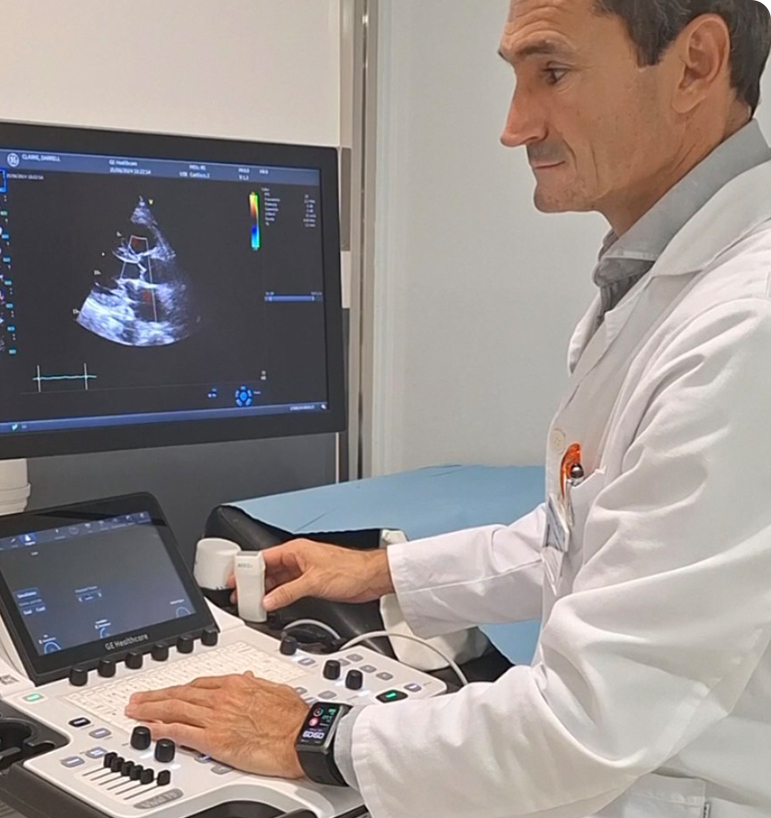Smart Blood Pressure
Monitoring:
Sleep, Train and Live Well

Reading duration: Approximately 10 minutes

Dr. Vicente Bertomeu-Gonzalez
Dr. Vicente Bertomeu-Gonzalez, a senior cardiologist with over 20 years of experience, heads the Cardiology Department at Hospital Clínica Benidorm in Alicante, Spain. His expertise lies in cardiac arrhythmias and blood pressure management. A prolific researcher with over 200 publications, Dr. Bertomeu actively contributes to the Eruopean, Spanish, and Valencian Societies of Cardiology. He also holds an associate professorship at the University Miguel Hernandez in Elche, Spain.
In this article
Blood Pressure Monitoring: What is it and why is it important?
Blood Pressure Monitoring During Exercise – From Traditional Methods to Innovative Solutions
The HUAWEI WATCH D2 / HUAWEI WATCH D as Health Companion
Blood Pressure Monitoring During Sleep
Conclusion

Blood Pressure Monitoring: What is it and why is it important?
What exactly is blood pressure?
Blood pressure is a vital sign essential for ensuring an adequate blood supply throughout the
body, supplying organs and tissues with the oxygen and
nutrients they need. Our body has a complex physiological control system that adjusts blood
pressure based on our activities and needs. For example, during physical exercise, our blood
pressure increases to deliver more oxygen and nutrients to the muscles. Conversely, during
periods of rest, relaxation, and sleep, the body reduces blood pressure to promote recovery and
conserve energy.
Why is it important to monitor your blood pressure?
Maintaining regular control of your blood pressure is crucial to prevent long-term health
problems. Hypertension, or high blood pressure, is often called the "silent killer" among
medical professionals because it can go
unnoticed for years while causing significant damage to vital organs. High blood pressure can
lead to serious conditions such as heart disease, kidney failure, and stroke. Regular monitoring
allows you to detect hypertension early, enabling you to take proactive steps to manage it
through lifestyle changes or medication. By keeping your blood pressure in check, you can
significantly reduce the risk of these severe health issues and maintain a longer, healthier
life.
Blood Pressure Monitoring During Exercise – From Traditional Methods to Innovative Solutions
Measuring blood pressure during exercise is a common practice in
medicine, because it provides valuable insights into cardiovascular health and helps identify potential issues that may not be apparent at rest. Regular
monitoring during physical activity can reveal how well the heart and blood vessels respond to exercise, helping doctors diagnose conditions such as
hypertension, arrhythmias, and other cardiovascular disorders.
The behaviour of blood pressure during exercise is complex. In general, there is a progressive increase in systolic blood pressure due to increased force of contraction of the heart, while diastolic blood pressure is maintained or even reduced by arterial vasodilatation. These changes can be influenced by
numerous elements, such as the presence of hypertension, pharmacological treatment, the physical condition of the individual or the presence of other pathologies.

Traditionally, stress tests and ambulatory blood pressure monitoring (ABPM) systems have been used for this purpose. However, these measurements are limited to activities such as walking or running on a treadmill and riding an indoor bike, either in a medical consultation or a gym. Traditional
measurement systems, with their large cuffs and monitors, do not allow their use during more varied physical activities.
Nowadays, the HUAWEI WATCH D2 offers ABPM capabilities, making it a game-changer in the realm of mobile health monitoring. As a smartwatch, it combines the portability and convenience of continuous blood pressure tracking with a wide range of health features, such as ECG, heart rate, and activity monitoring. This allows for comprehensive health insights in real-time, without the bulkiness of traditional systems. The lightweight design and ease of use make it ideal for active lifestyles, enabling blood pressure monitoring during a variety of physical activities, not just during rest or controlled tests. This seamless integration into daily life provides users with the flexibility to monitor their health anytime, anywhere.
The advent of smartwatches with integrated sphygmomanometers
(inflatable blood pressure cuffs) has revolutionized the ability to measure blood pressure reliably and conveniently in virtually any situation. This allows us to monitor blood pressure during actual physical activity, not just in
simulated environments. Activities like golf, sailing, climbing, hiking, Nordic walking, or calisthenics present very different physiological demands from conventional stress tests. Thus, this innovation enables more accurate
tracking of data and better adaptation of fitness regimes to ensure optimal heart health.

Good to Know:
What is a Sphygmomanometer?
A sphygmomanometer is a device used to measure blood
pressure, first clinically applied by Austrian physician Karl Samuel Ritter von Basch in 1881. It consists of three main parts:
1. Inflatable Cuff: Wrapped around the upper arm to restrict blood flow.
2. Measuring Unit: Displays blood pressure readings, either using mercury or an aneroid gauge.
3. Inflation Mechanism: A manual bulb or electronic pump to
inflate the cuff.
The cuff is inflated to restrict blood flow, then gradually
released. As the pressure decreases, a stethoscope or
electronic sensor is used to listen for blood flow sounds,
determining systolic and diastolic pressure readings.

Before the HUAWEI WATCH D2, some of my patients are reluctant to undergo automatic ambulatory blood pressure monitoring due to the discomfort of the cuff and device. Additionally, the scheduled test day may not align with the patient's moments of greatest concern. Recommending a smartwatch, such as the HUAWEI WATCH D2 or HUAWEI WATCH D, to my patients has enabled me to accurately monitor even the most demanding individuals. Its comfort and ease of use provide a seamless experience, allowing patients to track their blood pressure accurately at their convenience.

Take control of your health with the HUAWEI WATCH D and HUAWEI WATCH D2 – your personal, portable blood pressure monitors. Effortlessly track your vitals anytime, anywhere with just a tap on your wrist. The HUAWEI WATCH D2 enhances this with 24-hour Ambulatory Blood Pressure Monitoring (ABPM), giving you continuous and accurate tracking throughout the day. Safe, reliable, and always at hand, it's the smart choice for those who prioritize their wellbeing. Don't let hypertension catch you off guard – stay informed with the HUAWEI WATCH D and HUAWEI WATCH D2.
The HUAWEI WATCH D2 / HUAWEI WATCH D as Health Companion
Real-Time Monitoring During Exercise
The use of a smartwatch sphygmomanometer like the HUAWEI WATCH D represents a significant advance in blood pressure monitoring during exercise. Its reliability, comfort, and ability to adapt to various physical activities make it a useful tool for anyone who wants to monitor their health effectively. Whether you're hiking, cycling, or engaging in more relaxed sports, you can now monitor your blood pressure in real-time, in your own time, independent of a doctor’s appointment, and gain valuable insights into your cardiovascular health.
During a recent family holiday, we all put the HUAWEI WATCH D to the test across various activities and were fascinated by its accuracy and ease of use. It seamlessly recorded our blood pressure whether we were hitting the gym, or going on the bike. For example, after a 30-minute cycling session, we noticed a significant increase in systolic blood pressure, rising from a baseline of 120/80 mmHg to around 150 mmHg, reflecting the heart’s increased effort to supply oxygen to the muscles.
What stood out was how quickly our blood pressure returned to normal after exercise. Within about 10 minutes of rest, systolic pressure dropped back to baseline, indicating a healthy cardiovascular recovery. This ability to track blood pressure before, during, and after exercise provided valuable insights into our cardiovascular health, making the HUAWEI WATCH D a powerful tool for active health management.


HUAWEI WATCH D2
Ambulatory Blood Pressure Monitoring Precisely manage your health every moment
All-round Health Management
Light and Slim Design
Smart Living Experience Bluetooth calling, music playback and more
Medically Certified
Compatible with iOS and Android

Real-Time Monitoring in Challenging Environments
However, the HUAWEI WATCH D's capabilities extended beyond self-care. During a visit to the Philae Temple in Egypt, a visitor suffered from heat stroke due to extreme temperatures, exhibiting symptoms of severe hypertension and sinus bradycardia. Fortunately, I was wearing my HUAWEI WATCH D that day, and with the visitor’s consent, I placed it on his wrist. The visitor was then guided to a shaded area to rest and rehydrate with water. Thanks to the timely intervention and the watch's accurate readings, the patient made a full recovery. The experience highlighted the value of having reliable health tools in challenging environments.
Sinus bradycardia is a condition where the heart rate drops below 60 beats per minute, which is slower than the normal resting heart rate for most adults. It originates from the sinus node, the heart's natural pacemaker, and is considered normal in some cases, especially in athletes or during sleep.
Blood Pressure Monitoring During Sleep
Natural changes in blood pressure during sleep are well-documented and closely related to overall health and cardiovascular prognosis. During sleep, blood pressure typically dips, allowing the heart and blood vessels to rest and recover from the day's activities. This nocturnal dip is crucial for cardiovascular health; a lack of significant blood pressure reduction at night, known as "non-dipping," can indicate an increased risk of heart disease, stroke, and other cardiovascular problems.
In clinical practice, blood pressure behaviour during sleep is used to assess patients' cardiovascular health. For instance, patterns such as "dipping," "non-dipping," and "rising" blood pressure during sleep provide valuable
insights into a person's cardiovascular system's state. These patterns can inform a medical professional’s decision about initiating or adjusting
treatments for hypertension and other related conditions. This is supported by recent research which emphasizes the importance of these nocturnal blood pressure patterns in managing hypertension effectively.

•Dipping: Blood pressure drops by more than 10% during sleep, indicating healthy cardiovascular function.
•Non-Dipping: Blood pressure drops by less than 10%, known as non-dipper hypertension, increasing the risk of heart disease and stroke.
•Rising: Blood pressure increases during sleep, signaling potential cardiovascular issues.
However, traditional systems for measuring blood pressure during sleep are rudimentary and primarily schedule-based. This means, these methods involve fixed times for measurement, which do not account for individual variations in sleep patterns and routines.
Limitations of traditional methods for blood pressure monitoring during sleep
•Variable Schedules: Not everyone goes to bed and wakes up at the same time, and schedules can vary even for
the same individual throughout the week.
•Sleep Outside Regular Hours: It is not uncommon for some people to take a nap during the day or try to sleep
during a train or plane trip.
•Sleep Onset: Many people take a while to fall asleep after going to bed, making precise blood pressure
measurement based solely on schedule even more
complicated.
These limitations highlight the need for more advanced and flexible
monitoring solutions to accurately track blood pressure changes during sleep and provide a clearer picture of
cardiovascular health.
Sleep Smarter with HUAWEI TruSense™ Technology
Huawei’s TruSense™ technology offers an advanced solution to these
limitations. This technology allows automatic sleep detection by
considering parameters such as movement, heart rate, and respiratory rate. This enables the watch to identify when
you are truly asleep, allowing it to switch to sleep monitoring mode and record the appropriate
measurements.
Proper blood pressure recording in hypertensive patients allows the
classification of patients into three different categories:
•Dipper (those who experience a significant reduction in blood pressure during sleep, the physiological pattern)
•Non-dipper (those who do not experience this reduction)
•Riser (those who have an increase in blood pressure)

These classifications are essential for medical professionals determining whether to start or adjust pharmacological treatment for their patient. By identifying
potential signs of disrupted sleep, TruSense™ can provide valuable insights for your doctor, helping them understand if your sleep is being affected.
In the HUAWEI Health App, you can view comprehensive sleep data, including when you fall asleep, wake up, and experience sleep arousals. This data can be analysed alongside your blood pressure readings, offering a complete view of your cardiovascular health. While the HUAWEI WATCH D currently doesn't allow you to schedule blood pressure measurements in advance, The HUAWEI WATCH D2 revolutionises this process by offering continuous, real-time blood pressure monitoring. Compared to the previous model, the HUAWEI WATCH D2 has an ambulatory blood pressure measurement management feature that continuously measures blood pressure over 24 hours.
Advantages of the Smartwatch with Blood Pressure Monitoring
•Reliability and Precision: Provides accurate and consistent measurements. A recent study found that the HUAWEI WATCH D provided results that were consistent and accurate when compared to the gold standard clinical sphygmomanometer. Additionally, this study showed that elderly users valued the accuracy of blood pressure monitoring, which helped them stick to regular use.
•Comfort: The smartwatch is designed for comfort, making it easy to wear throughout the day in any situation. Its lightweight and ergonomic design ensures that it doesn’t interfere with daily activities, making continuous monitoring effortless
•Portability: Unlike traditional blood pressure monitors, the smartwatch is compact and portable, allowing users to monitor their blood pressure anywhere and at any time. This convenience ensures that health tracking can seamlessly fit into even the busiest lifestyles.
•Freedom of Movement: The smartwatch does not restrict movement, enabling users to carry on with their regular activities while still monitoring their health. Whether you’re exercising, traveling, or relaxing, the device can adapt to your needs without getting in the way.
•Ease of Use: With its intuitive design, the HUAWEI WATCH D is user-friendly and accessible.
•Robustness: Built to be durable, the HUAWEI WATCH D is resistant to damage and designed to be worn throughout the day. This robustness makes it ideal for long-term use
•Integration with Applications: Information collected by the smartwatch is automatically downloaded to an application, allowing easy and organized access to data. This makes it easy to share all important health information with your doctor or physical trainer.
Conclusion:
The use of a smartwatch sphygmomanometer like the HUAWEI WATCH D2 represents a si gnificant advance in blood pressure monitoring during both exercise and sleep. Its reliability, comfort, and adaptability make it a helpful tool for effectively monitoring health in daily life. The possibilities it offers are wide and varied, allowing any user to find a utility that suits their specific needs. Whether for athletes looking to optimize performance or individuals seeking consistent cardiovascular health tracking, the HUAWEI WATCH D provides personalized and efficient solutions for every lifestyle. However, in the event of possible symptoms and health-related issues, a doctor should always be consulted.

Medical disclaimer:
The HUAWEI WATCH D2 / HUAWEI WATCH D and the ECG feature is intended to be used by people aged 18 years and over, but is not intended to replace any medical diagnosis or treatment. Data obtained during the use of this device and feature is for personal reference only. Before using the device, please carefully read the Quick Start Guide, Wearing Guide, and Instruction for Use.
Due to national restrictions on obtaining approval / registration as a medical device, the HUAWEI WATCH D2 / HUAWEI WATCH D will only be available in selected European markets, and the ECG feature only works on watches and smartphones purchased in countries where the service is available.
- Supported smartphones: Mobile phones with Android 6.0 or compatibles, HarmonyOS 2.0 or compatibles, or iOS 12.0 or compatibles. The Huawei Health app version on your mobile phone must be 11.0 or compatibles. Please make sure that your wearable device and phone are running the latest versions before using ECG.
Heart rate, SpO2, stress and skin temperature are not medical device features. Monitoring data and results are for reference only and should not be used as a basis for medical diagnosis or treatment.
[References]
- 1. Liu, Y., Lv, Z., Zhou, S., Fu, Z., Wang, Y., Yi, L., … Chen, Y. (2024). A smartwatch sphygmomanometer-based model for predicting short-term new-onset hypertension in individuals with high-normal blood pressure: a cohort study. Clinical and Experimental Hypertension, 46(1). https://doi.org/10.1080/10641963.2024.2304023
- 2. Yano, Y., Kario, K. Nocturnal blood pressure and cardiovascular disease: a review of recent advances.Hypertens Res 35, 695–701 (2012). https://doi.org/10.1038/hr.2012.26
- 3. Yi, L., Lv, Z. H., Hu, S. Y., Liu, Y. Q., Yan, J. B., Zhang, H., Li, H. B., Chen, Q., Li, Y. Y., Jiang, Y. F., Zhou, H., Li, M. D., Chen, R. D., Li, X. L., Zhou, S. S., & Chen, Y. D. (2022). Validating the accuracy of a multifunctional smartwatch sphygmomanometer to monitor blood pressure. Journal of geriatric cardiology : JGC, 19(11), 843–852. https://doi.org/10.11909/j.issn.1671-5411.2022.11.004
Administrator
Copy successful

